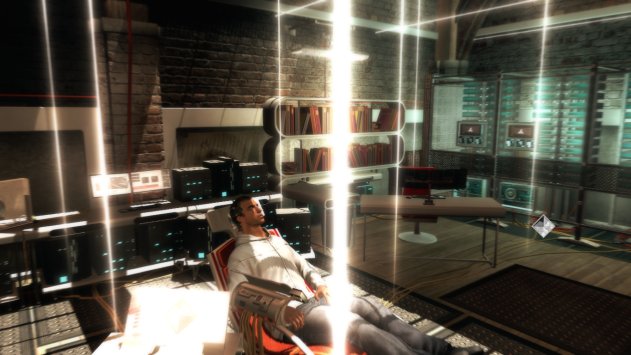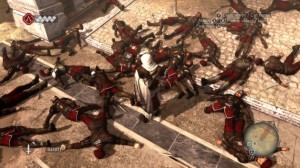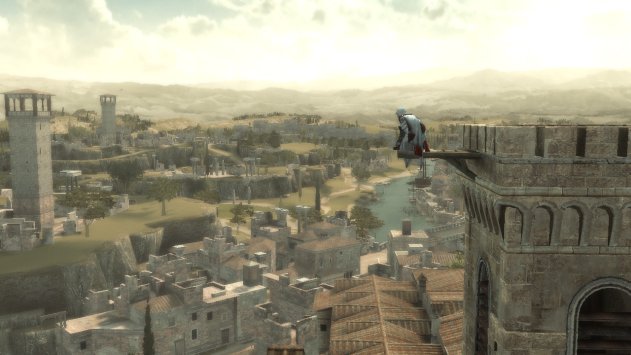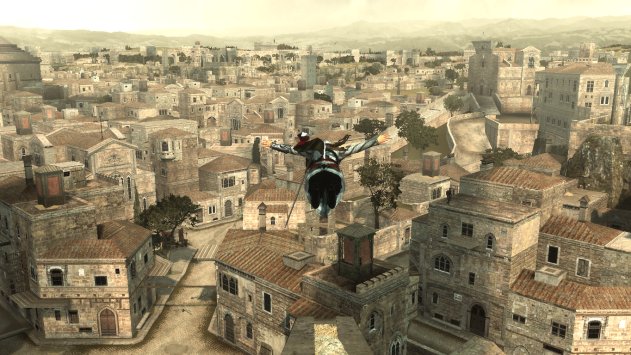
Assassin’s Creed is one of the defining series of the seventh console generation, with all five mainline games on current-gen hardware. Its sprawling environments, hundreds of concurrent NPCs and attention to detail simply wouldn’t have been possible in the days of GameCube. As Nintendo kickstarts the next console generation with the Wii U, a system eclipsing most of the specifications of the aged PS3 and Xbox 360, Assassin’s Creed III is a title that will be instrumental in integrating the Nintendo home console in the multi-platform release market once again. Seeing as this is the first Assassin’s Creed game for a Nintendo home system (two spin-offs were released on the DS), Nintendo-exclusive fans may know little about the franchise. What is Assassin’s Creed, anyway?
Assassin’s Creed is, at its core, a speculative historical open-world stealth series, where the primary goal is to assassinate key targets (preferably with your forearm-mounted Hidden Blade) and successfully escape using your parkour skills. While the later games have steered away from this direction, introducing several gameplay elements that turn you more or less into a period John Rambo, the base stealth mechanics have always remained an option. It’s a shame, then, that those mechanics have remained the same clunky mess over the course of four games. Sneak your way past underlings, kill the top dog (which blows your cover), run away from guards, then round a corner and join a crowd, sit on a bench, or hide in that trademark of the series, the ever-useful and ubiquitous haystack.

This central gameplay conceit goes hand-in-hand with the central story conceit. You, Desmond Miles, are a modern-day member of the Assassin Order in the middle of a cold war with your ancient enemies, the Templars. To prevent the Templars from furthering their goals, you must look to your Assassin ancestors for help— they were involved in this war, too, and hid numerous critical artifacts all over the globe— by reliving their lives. Desmond spends much of the game hooked up to the Animus, a kind of dentist’s chair that uses his DNA and the hypothetical concept of genetic memory to enter a highly realistic simulation of past events.
This plot device contributes significantly to grounding the series to the medium— staples such as invisible walls and game overs are a result of you performing acts that technically didn’t happen to your ancestor. And because the breathtaking vistas are only a simulation, the incremental improvements in graphics and AI between sequels may be attributed to “improvements to the Animus”. It’s a solution to a problem that didn’t really need solving, but it’s a fitting meta-fictional touch nonetheless.
 As the series has progressed, the focus has been less on the “stealth” aspect of assassination and more and more on the “killing” bit. Giant battle axes, dual Hidden Blades and bombs have all become part of your repertoire, with much of the combat resembling a brawl from the Arkham Batman games only with far less elegance.
As the series has progressed, the focus has been less on the “stealth” aspect of assassination and more and more on the “killing” bit. Giant battle axes, dual Hidden Blades and bombs have all become part of your repertoire, with much of the combat resembling a brawl from the Arkham Batman games only with far less elegance.
Add that to the increasingly convoluted plot worthy of Dan Brown involving ancient aliens, hidden messages in famous works of art, and the true nature the world’s mythologies, and the series is cumbersome enough to overwhelm. The lush but ultimately empty open world– functionally empty unless you enjoy busywork, that is– can be seen to only artificially pad the playtime.
Despite all this, though, Assassin’s Creed is my guilty pleasure. I’m fascinated by alternate histories and conspiracy theories (the former because they are interesting “what ifs”, and the latter because they’re funny), and these are the bread and butter of the series. There’s nothing quite like standing your ground in front of Richard the Lionheart or sitting down with Leonardo da Vinci and asking him for a weapon upgrade. The games may have suffered from burnout since becoming an annual series, with the last game Revelations offering only minor gameplay upgrades, an unnecessary tower defense minigame, and plots that were essentially filler, but its recreation of Constantinople along with its improved traversal made it worth a run.
In fact, these two factors— the place and the parkour— are my primary reasons for loving Assassin’s Creed. Each game is much like a virtual vacation, and you are the world’s most agile tourist. Practically no other video game has explored the locales that Assassin’s Creed has— apart from Constantinople, the series has featured historic cities such as Acre, Jerusalem, Damascus, Florence, Venice, and Rome, exteriors of all of which can be fully explored via fluid parkour that is a more realistic version of the mobility of the modern Prince of Persia.

These cities are painstakingly researched for accuracy, although they are shrunken to facilitate the pace of play. The first time you scale a tower and soak in the city will make you gasp. The combination of the timeless architecture and fictionalized historical characters leads to the incredible sense of immersion that the games engender— try playing any of the Renaissance games with Italian audio and without any of the HUD elements.
This exploration of niche settings continues with Assassin’s Creed III, set in the American colonies during the Revolutionary War. After three games with the same protagonist ancestor, the new lead Connor Kenway, a half-English, half-Mohawk character, appears set to shake things up a bit. The current-gen console versions came out two weeks ago, garnering much critical acclaim, and everything in these versions has been preserved for the Wii U version. Additionally, the game has full, TV-optional, GamePad functionality, letting you assassinate in bed or on the can. However, on the big screen, it is reportedly running natively at 1080p, well and above the Xbox 360 or the PS3’s 720p, which would make it second only to the PC in terms of visual fidelity.
The arrival of Assassin’s Creed on the Wii U meshes well with Nintendo’s thrust towards increased third-party involvement, and along with Call of Duty: Black Ops 2, indicates that the Wii U won’t get shafted with late or sub-par entries from established franchises like the Wii did (even though games such as Mass Effect 3, Ninja Gaiden: Razor’s Edge, and Batman: Arkham City would seem to suggest the exact opposite). Never tried Assassin’s Creed before? It’s time to put on those white robes and take that leap of faith.





 ShareThis
ShareThis






